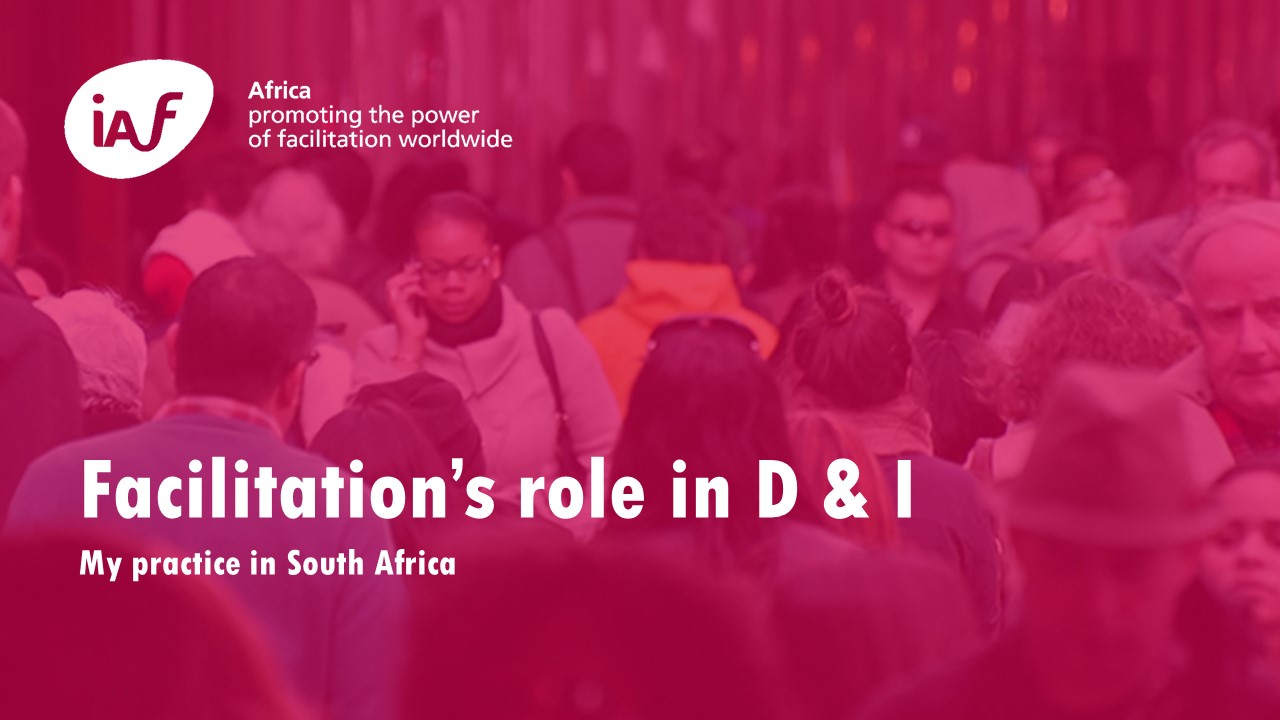Global Flipchart #16
September 2019
Facilitation's role in D & I

I think that long before I was involved in facilitation processes (talking late 60s to early 80’s now!), I felt that there must be a better way to work with people! A way which respects them, makes space for all and takes their views seriously. In my earlier CVs I listed that effort as ‘Participatory ways of working with people.’
Many of my efforts at the time were focussed on less formal work with groups in a workshop setting but more in Community Development and Community Organising with people at the base.
So when I saw this topic for an IAF publication my immediate response was: ‘Surely this is almost tautological and redundant’: Facilitation in itself is about recognising and respecting difference/ diversity and through the balancing of Task (getting the job done) and Maintenance: (paying attention to the involvement and participation of all) functions in a group: ensuring Inclusion!
So, using Facilitation to engender and promote respect for difference and working for Inclusion will result in greater ownership of both the need and a conviction to do likewise in the wide world. Why? Because as a participant in a facilitated process, regardless of my age, my race, my gender or sexual orientation, my ethnicity, my education or class, my language, my contribution was respected and had equal value. If I felt included and respected in this process; why then should we not be consistent and inclusive in all that we do?
And so in workshops on understanding the nature of oppression (Racism, Sexism etc.) and how it feeds exclusion and building a model of inclusion (racial/gender justice etc.), we commit upfront to doing it in a participatory way. And we do! Telling the participants that they are the most important ingredient in the room: ‘This process will not work without your full participation!’
This model that we use is built up in an affective process as shown below:
ATTITUDES
Assumptions
Stereotypes
Prejudices
Values
+
POWER TO ACT
=
DISCRIMINATION
+
IDEOLOGY OF SUPERIORITY (e.g. Male, White etc.)
=
EXCLUSION & OPPRESSION (e.g. Sexism, Racism etc.)
To make learning accessible and inclusive, the learning on the Model is divided into segments which focus on:
- Power and power relations (in and beyond the room)
- Our socialisation into the attitudes we hold
- How negative attitudes impact on actions resulting in (racial, sex, class, age and other) discrimination
- The Forms the discrimination takes: direct, indirect etc.
- What the discriminatee is denied: always Self-respect and other tangible losses which can be summarised as Opportunities, Resources and Services
- Activities which engender learning on the impact of discrimination on the behaviour and response of the victim together with the denial of the discriminator, is also part of the path
- The difference between Discrimination and the ‘isms’ (sexism, classism, racism, hetero-sexism etc.) and insight into their systemic nature and consideration of the Model/Definitions
For the second half of the three day workshop, apart from deepening recognition of these ‘isms’ (forms of oppression/exclusion) and providing opportunity to identify examples of how they function in our work (always contextually) participants are assisted with building inclusive ways of working with people. These include policies and practice; the physical work environment, formal and informal organisational culture and how we will monitor these. Tools for challenging oppression in our work, family and general life contexts, are also developed.
The workshop usually ends with individual goal setting which are shared in a closing circle. The goals and final sharing in the closing circle are usually encouraging and demonstrate:
- Ownership: to what extent the process has enabled me to OWN the reality of the forms of oppression in my work and life practice
- Understanding: Am I now able to distinguish between Attitudes (e.g. Racial/gender prejudice), Discrimination and actions which are sustained by Ideologies of Superiority (e.g. Classism, Adultism, Able body-ism, Racism, Sexism etc.)
- Motivation: Am I sufficiently armed with knowledge which motivates me to push against, where I have power and responsibility, to push against my former collusion with oppression.
- Action: will I take action in my work and beyond which, wherever I am able, will contradict Ideologies of Superiority (Male, Heterosexual, Adult, Class etc.) in order to promote inclusion
For more information, reach out!